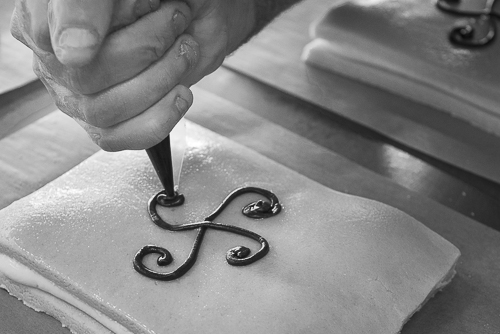Having entered the Bizkarra bakery, which is housed in a nondescript brick building, I first thought I had arrived at a factory and that we had come to the wrong place. Instead, my first impression was, if not wrong, very far from the truth. This bakery was founded in 1957 by Esteban Bizkarra and we were shown around the bakery by Eduardo Bizkarra, one of his grandsons. At first sight, it seemed like the workers were just operating machines, but after some time, which lasted up to 4(!) hours, I could see first-hand that the machines did all the heavy and repetitive work, while the workers, who were trained bakers, were doing manual work occasionally, like shaping each bread manually by deft hands. Since demand for breads from this bakery is very high, the breads have to be made fast.
The breads made at this bakery are either sourdough breads, where a starter is used to start fermentation or yeast, which is expected to ferment for 16 hours, is used. The philosophy of this company is to not rush thing and let nature take its time. This has the added advantage that the workers can prepare dough in the afternoon and let it ferment overnight.
Parts of the flour, which is used at this company, has been certified and the cereals have been grown in Álava, located in the south of the Basque Country, where they have been turned into flour.
Sourdough starters contain yeasts and lactic acid bacteria. While the yeasts expand bread by leaving air pockets after baking, the lactic acid bacteria improve taste, sight, smell and touch of bread as well as their shelf life, nutritional value and wholesomeness. A sourdough starter contains thousands of different microorganisms, which will leaven bread slowly.
The sourdough starter has to be renewed regularly and each time it is used for making bread, a part of it is kept for the next bread-making. The microorganisms in the sourdough starter are kept alive by giving them nutrients like flour for food and water for drinking. It is also necessary to stir it such that the microorganisms can breathe.
Actually, the Bizkarra company consists of both a bakery and a confectionery and Eduardo willingly showed us both, sometimes showing us some type of cake being made in the confectionery before going back to the bakery where we could, e.g. watch freshly shaped pieces of dough enter an oven by means of a machine or using the same machine to take them out again, creating a pleasant fragrance. He also picked small pieces of freshly made dough and pulled it almost apart, showing us some of its characteristics. Likewise, he described the characteristics of a freshly made bread on which the bakers had made a pattern in the dough before baking by means of a knife. Being an expert, he could perceive imperfections, which would have been more or less invisible to anyone else.
Eduardo likes to research old recipes as well as bakery history and ancient cereals always looking for new ways to improve his company.
In the confectionery, lots of different types of sweets were being made. We were shown sweets typical of the province of Bizkaia, like «pastel de Arroz» , «bollo de mantequilla» «carolina» and «pastel vasco» were made manually, but as usual, with the help of machines. A machine, which seems to be ubiquitous in confectioneries are rollers, which flatten the dough. First, the confectioner makes the dough relatively flat by means of a rolling pin, then the dough is put in the roller where it is compressed several times until it is as thin as required.
One of the cakes called «pastel vasco», meaning Basque cake, was made by pressing a stencil on the flat dough, making lots of equal pieces. Then, each piece was covered by filling by means of a pastry bag, then another piece of dough was put on top. Finally, an elaborate pattern called «Lauburu» was drawn on top of each piece before baking them. Later, fragrant and pleasant-looking cakes were taken out of the oven. The «lauburu» is an old symbol of the Basque Country and the unity of the Basque people.
We could also watch various other types of sweets being made where ingredients like flour, sugar, butter, milk and eggs were mixed together and turned into delicious miracles. For instance, one of the confectioners, having made a filling, applied it to small containers of pastry dough casing, looking like a filled pie. After having leavened and baked them, they were left for cooling, then a confectioner would apply another type of filling on top of the filled pie, forming a sort of spiral on top of it. Finally, it was dipped in chocolate liquor.
Lots of other delicious and fragrant sweets were made, almost drowning our senses in good feelings.
To finish, Eduardo has also teamed up with a cattle farmer, Sandra Lejarza, who sells high quality veal burgers, in order to create a combined product, consisting of four hamburgers with meat from her own cattle and four sourdough breads slowly fermented and not fully baked. In fact, the bread should be baked just before it is eaten.
Later, the same day, we would go to visit Sandra Lejarza who would cook a meal for us and Eduardo would bring some of his delicious breads and cakes.

